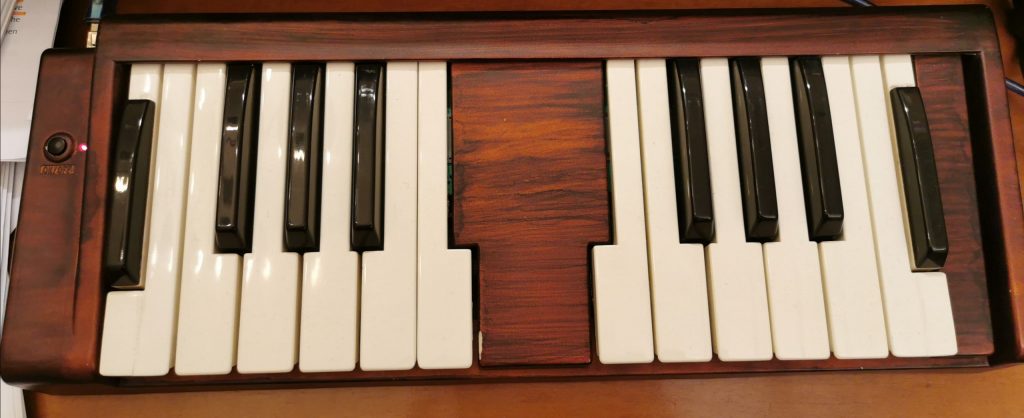Introduction
After the first personal computers appeared in the late 1980s, shorthand typing underwent a deep computerization process that led it to offer increasingly sophisticated products. This allowed professionals to have more and more advanced softwares and ergonomic keyboards which are now totally computerized, no longer producing any strip of paper and sometimes equipped with hard disk, LCD screen, internal processor and built-in sound card. Transcription softwares can offer numerous additional functions, from synchronized audio recording to real-time editing. This has raised the initial investment to enter this profession as high as around $1,500 to $2,000, removing many potentially interested people. This has resulted in a need for open source softwares.
The purpose of this article is to present the digitization of Italian stenomachines in the era of open source softwares. More specifically, we will describe the Italian Open Steno project and the Plover transcription software that has been developed as part of it.
The Open Steno project
The Open Steno project was initiated in 2010 to make stenography accessible to everyone and spread the use of stenotyping to a much wider audience. Many people could start cultivating an interest and using second-hand material before discovering their passion for stenotyping and beginning to learn it seriously. Therefore Plover, the first free steno transcription software, was created, aimed at helping people who cannot use their voice to communicate, want to reduce the risks of repetitive strain injury (RSI) or are interested in wearable computing. It has also helped programmers who want to write down their ideas quickly and more fluently as a fast text input. Plover allows anyone to take the first steps in digital stenotyping for free, even using the regular QWERTY keyboard to emulate the steno keyboard or a pen shorthand system whose graphic signs are based on the combinations of the steno keyboard in order to switch from one system to another, using the same abbreviations.
Advantages of an open steno software
The Open Steno project has been welcomed by many enthusiasts who have contributed to its development. Currently there are 35 available plugins that allow users to interface the program with almost all existing steno keyboards. Functionally, Plover cannot be compared with commercial software: it has a very basic interface which simply translates the steno notes in any computer window active in the current moment. Because of this, the stenotypist must adopt a conflict-free theory where each stroke or combination of strokes corresponds to one entry. However, thanks to this, Plover is easily used with, for example, the Italian Melani steno system, which works well with these principles.
Plover and the Michela stenomachine
In September 2017 Plover was interfaced with the Michela-MIDI steno keyboard used at the Italian Senate in order to increase the Senate’s services to the public, in particular to schools and young citizens. For example, the Michela machine has been used with Plover in blind mode, with the Braille alphabet and a special printer, to set up educational workshops for visually impaired people during National Braille Day. Using Unicode characters in native mode, the Michela stenomachine may be used, in principle, with every language in the world. Utilizing this feature, an Arabic dictionary was built in Plover to stenotype speech in Arabic during a visit of the Tunisian Parliament’s delegation to the Italian Senate.
To increase people’s awareness of stenotyping, the Michela keyboard has been used with Plover software at some public events. For example, because of its structural likeness to a piano, it has been used as a common MIDI musical keyboard. Also, in 2019 the Michela stenomachine was reproduced as the first functional LEGO steno keyboard in history. Moreover, during the 52nd Biennale at Venice, the Michela steno keyboard was used to transcribe a poem and translate it into a musical score as an ordinary music keyboard in connection with a music notation software. At the same time, the keyboard was connected to Plover to transcribe the text of the poem.

Using a steno keyboard as a regular keyboard
Basically, a keyboard is just an interface that we can use to “talk” with an IT system, and many applications can be managed only via keyboard. Because Plover can be used to simulate a QWERTY keyboard by using a stenomachine, and because it allows the user to deeply customize shortcuts and strokes, it is easy to imagine how a steno keyboard could also be a useful tool for purposes other than transcribing spoken text. For example, the steno keyboard can be used instead of a regular keyboard to navigate different kinds of interface, from the operating system to a file manager, web browser, word processor or any other application which is accessible with only a keyboard, without a mouse. This is especially good for visually impaired users. Also, one can use a macro system to make the workflow more efficient, recording actions and using the keyboard as input to run them. The final target is to save time: when one does not need to move one’s hands from the steno keyboard to the QWERTY keyboard, the general workflow becomes faster.
The advantages of Plover to blind people
One key objective with Plover has been to make the stenographer’s job accessible to blind people. Plover has a plugin system where users can share additional features. This allows the creation of a plugin which links a screen reader application to the keyboard output text. This way the user has clean audio feedback of what he or she is typing in real time. It is like talking with one’s hands, because a synthetic voice speaks the output text aloud. In this way, a blind user has knowledge of everything that is happening on the screen even though he does not see it.
Conclusions
Using a stenotype machine with an open steno system enables the user, connected in any language, to lower the cost of stenotyping. In this way, the open steno system has increased the number of stenotypists. The digitalization of stenomachines has widened their usability, helped them to evolve and kept them up with the times.
Daniele Casarola is a stenographer and a respeaker and works as a court reporter and a real-time subtitler in Italy. Giulia Torregrossa is a stenotypist with the Michela stenomachine and a parliamentary reporter at the Italian Senate.
Further information
Open Steno Project: http://www.openstenoproject.org
Stenolab: www.stenolab.it





[…] Casarola D. & Torregrossa G. (2020). Italian shorthand machines in the open source era, in Tiro 1/2020. Retrieved from: https://tiro.intersteno.org/2020/05/italian-shorthand-machines-in-the-open-source-era/ […]